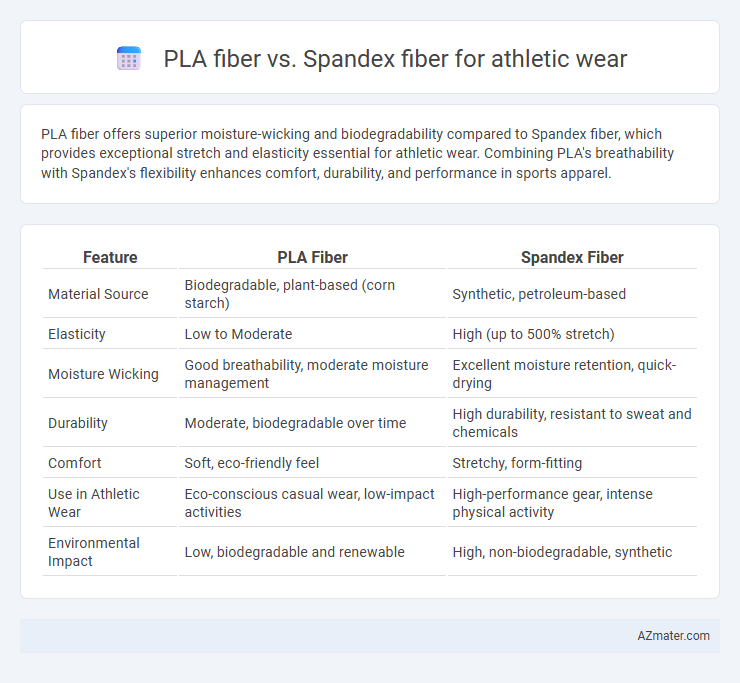PLA fiber offers superior moisture-wicking and biodegradability compared to Spandex fiber, which provides exceptional stretch and elasticity essential for athletic wear. Combining PLA's breathability with Spandex's flexibility enhances comfort, durability, and performance in sports apparel.
Table of Comparison
| Feature | PLA Fiber | Spandex Fiber |
|---|---|---|
| Material Source | Biodegradable, plant-based (corn starch) | Synthetic, petroleum-based |
| Elasticity | Low to Moderate | High (up to 500% stretch) |
| Moisture Wicking | Good breathability, moderate moisture management | Excellent moisture retention, quick-drying |
| Durability | Moderate, biodegradable over time | High durability, resistant to sweat and chemicals |
| Comfort | Soft, eco-friendly feel | Stretchy, form-fitting |
| Use in Athletic Wear | Eco-conscious casual wear, low-impact activities | High-performance gear, intense physical activity |
| Environmental Impact | Low, biodegradable and renewable | High, non-biodegradable, synthetic |
Introduction to PLA and Spandex Fibers
PLA fiber, derived from renewable resources like cornstarch, offers biodegradability and moisture-wicking properties, making it a sustainable choice for athletic wear. Spandex fiber, known for its exceptional elasticity and durability, provides superior stretch and shape retention, essential for high-performance sports apparel. Combining PLA's eco-friendly nature with Spandex's flexibility often results in athletic garments that balance comfort, sustainability, and functionality.
Environmental Impact of PLA vs Spandex
PLA fiber, derived from renewable resources like corn starch, offers a biodegradable and compostable alternative to synthetic fibers, significantly reducing microplastic pollution in athletic wear. Spandex, a petroleum-based fiber, contributes heavily to environmental degradation due to its non-biodegradability and reliance on fossil fuels, leading to higher carbon emissions throughout production and disposal. Choosing PLA fiber in athletic apparel supports sustainability by lowering ecological footprints and promoting circular economy practices in the textile industry.
Comfort and Feel: PLA vs Spandex
PLA fiber offers a lightweight, breathable feel with excellent moisture-wicking properties ideal for athletic wear, promoting natural temperature regulation and skin comfort. Spandex fiber delivers exceptional elasticity and stretch recovery, providing a close, supportive fit that enhances freedom of movement during physical activities. While PLA feels softer and more natural, spandex excels in flexibility and durability, making the choice dependent on the desired balance between comfort and performance.
Moisture Management and Breathability
PLA fiber, derived from renewable plant resources like corn starch, offers excellent moisture management by quickly wicking sweat away from the skin, keeping athletes dry during intense workouts. Spandex fiber, known for its exceptional elasticity, provides superior breathability when blended with moisture-wicking fabrics, allowing for enhanced airflow and temperature regulation. PLA's natural biodegradability and moisture-wicking properties make it a sustainable alternative to spandex, which excels primarily in stretch and fit but requires blending to improve moisture management and breathability in athletic wear.
Stretch and Flexibility Comparison
PLA fiber offers moderate stretch but excels in moisture-wicking and breathability, making it suitable for low to medium-intensity athletic wear. Spandex fiber provides superior elasticity with up to 500% stretch, delivering exceptional flexibility and recovery essential for high-performance and dynamic sports activities. Combining PLA with Spandex blends can optimize comfort, durability, and stretchability in athletic apparel.
Durability and Longevity in Athletic Use
PLA fiber exhibits excellent durability due to its natural resistance to UV rays and microbial growth, making it suitable for prolonged outdoor athletic use. Spandex fiber offers exceptional elasticity and shape retention but may degrade faster with repeated stretching and exposure to sweat over time. Combining PLA's environmental resilience with Spandex's flexibility often creates high-performance athletic wear that balances longevity and comfort.
Allergies and Skin Sensitivity
PLA fiber, derived from renewable plant-based sources like corn starch, offers excellent breathability and moisture-wicking properties, minimizing irritation for sensitive skin and reducing allergic reactions compared to synthetic fibers. Spandex fiber, while highly elastic and favored for its stretch and flexibility in athletic wear, can sometimes cause skin sensitivity or allergic reactions due to chemicals used during manufacturing and tight-fitting garments trapping sweat. Athletes prone to allergies or sensitive skin often prefer PLA fiber for its natural origin and hypoallergenic qualities, promoting comfort during prolonged physical activity.
Cost and Availability in the Market
PLA fiber is generally more cost-effective due to its bio-based origin and increasing production scale, making it a competitive option for eco-conscious athletic wear brands. Spandex fiber, renowned for its superior elasticity, tends to have higher market prices influenced by synthetic manufacturing processes and fluctuating petroleum costs. Availability of PLA fiber is steadily improving with advancements in biopolymer technologies, while spandex remains widely accessible due to its established presence in the textile industry.
Performance in Various Athletic Activities
PLA fiber offers excellent moisture-wicking properties and natural breathability, making it ideal for endurance sports and activities requiring consistent temperature regulation. Spandex fiber provides superior stretch and recovery, enhancing flexibility and support during high-intensity workouts such as weightlifting and sprinting. Combining PLA with Spandex in athletic wear ensures a balance of comfort, durability, and performance across diverse athletic activities.
Future Trends and Innovations in Athletic Fibers
PLA fiber, derived from renewable resources like corn starch, offers biodegradable and moisture-wicking properties, making it a sustainable alternative to traditional synthetic fibers in athletic wear. Spandex fiber remains essential for its exceptional elasticity and shape retention, with ongoing innovations enhancing its durability and comfort through bio-based and recycled materials. Future trends emphasize hybrid blends combining PLA's eco-friendliness with spandex's stretchability, driving advancements in performance fabrics that address both environmental impact and athletic functionality.

Infographic: PLA fiber vs Spandex fiber for Athletic wear
 azmater.com
azmater.com